Last Winter I brought out Avalon Hill’s B-17 – Queen of the Skies. It had been awhile. When I opened the box, I found a mission sheet from October 1993 Needless to say, I would be starting from scratch, with the first order of business to get familiar with the rules.
After skimming the rules, I struggled through one mission. While the sequence of play is fairly intuitive and instructions well programmed, the chart sequence – with its alphanumeric designations and colors – was horrible to work with.
Frustrated, I copied all of the play aide sheets and literally cut-and-pasted them into a rough action sequence. The first sheet contained all the pre-mission events. The second sheet included the charts used to determine areas of damage, with third and fourth sheet reflecting actual damage. The final sheet contained charts used when over the target and if/when the crew needed to bail out or make an emergency landing. Any other information needed could be found on the map.
Although these edited sheets could be copied to cardstock, I left them on regular paper, stapled together. This way, I didn’t have sheets floating all over the gaming table.
Another change was discarding the B-17 schematic. This took up space on the table, and any crew actions, wounds, or damage could (and can) be noted on the individual mission sheet.
My annotations to the Mission Charts evolved over the course of the campaign. I’ve included the mission chart for Astro II’s final mission. As you can see, the crew was able to safely bail out over the Netherlands, after a fluke hit to the Number 4 engine.
This is fun and engrossing general simulation of the evolution of Pointblank, starting with limited and escorted missions over France and ending with the daunting long-range raids against strategic targets over Germany. It’s reputation as an outstanding game is well deserved.
The early missions are short, and can be played in about 15 minutes. The later missions can last over an hour, depending on how many waves of german fighters your aircraft encounters.
As with most (if not all) solitaire games there is a lot of wristage and charts involved, especially since one wave of fighters can return for additional attacks. On a long-distance mission, which would involve maybe 8 turns with the possibility of multiple waves of fighters, this can make for a long, grueling game.
I really can’t comment on the game as a simulation because my knowledge of Pointblank is macro and not micro. However, I do believe that the game has a great “feel” for what aircrews encountered from 1942 until the evolution of long range escorts such as the P-51 Mustang.
I was surprised at the number of superficial hits Astro II sustained. Whether this was a function of luck, or part of the game’s design I can’t tell. While the aircraft was able to shrug off hits, the crew was not. Over the course of 18 missions, four crew members were killed outright, or died of wounds; six crewmen were seriously wounded with four not returning to duty, in addition to 16 light wounds! Three crewmen suffered from frostbite when the heating system was hit.
Flak was typically not a factor over the target areas. Regardless, bombing accuracy was poor. Astro II failed to hit the target area seven times, and only once was accuracy as high as 75 percent. Twenty percent accuracy seemed to be the norm.
In my judgment, It is far more satisfying as a campaign game, trying to complete 25 missions, than a one game time filler. It really got tense on the longer missions where wave after wave of fighters attacked Astro II, with ammunition running low, crewmen injured, and damage effecting performance. Set-up time is minimal, and the game can be played on a small table or desk. I would typically play three shorter missions, and one or two longer missions, during one sitting.
Perhaps next winter a new Queen of The Skies will begin pounding the Third Reich.
